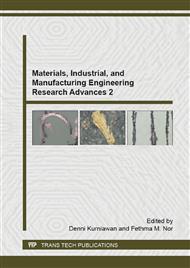[1]
E. Vejmelková, D. Koňáková, M. Čáchová, M. Keppert, R. Černý, Effect of hydrophobization on the properties of lime-metakaolin plasters, Const. Build. Mat. 37 (2012) 556-561.
DOI: 10.1016/j.conbuildmat.2012.07.097
Google Scholar
[2]
M. Čáchová, D. Koňáková, E. Vejmelková, P, Reiterman, M. Keppert, R. Černý, Properties of lime plasters with different ceramic powder dosage, Appl. Mech. Mat. 621 (2014) 19-23.
DOI: 10.4028/www.scientific.net/amm.621.19
Google Scholar
[3]
M. Čáchová, D. Koňáková, E. Vejmelková, M. Keppert, P. Reiterman, R. Černý, The properties of innovated mortars utilizing secondary raw material, WIT Trans. Built Environ. 137 (2014) 49-56.
DOI: 10.2495/hpsm140051
Google Scholar
[4]
E. Vejmelková, P. Máca, P. Konvalinka, R. Černý, Innovative lime-pozzolana renders for reconstruction of historical buildings, Adv. Mat. Res. 324 (2011) 372-375.
DOI: 10.4028/www.scientific.net/amr.324.372
Google Scholar
[5]
E. Uǧurlu, H. Böke, The use of brick-lime plasters and their relevance to climatic conditions of historic bath buildings, Const. Build. Mat. 23 (2009) 2442-2450.
DOI: 10.1016/j.conbuildmat.2008.10.005
Google Scholar
[6]
R. Agostino, G. Barone, P. Mazzoleni, S. Raneri, G. Sabatino, M. M. Sica, Mortars and plasters from the Bruttii - Roman city of Taureana (Palmi, RC, Italy) - preliminary data, Per. Miner. 82 (2013) 489-501.
Google Scholar
[7]
S. Gulzar, M. N. Chaudhry, J. P. Burg, S. A. Saeed, Characteristics of ancient mortars and plasters from the archaeological site of Akbari-Serai (Pakistan), Asian J. Chem. 25 (2013) 8484-8488.
DOI: 10.14233/ajchem.2013.14798
Google Scholar
[8]
E. Vejmelková, P. Máca, M. Keppert, P. Rovnaníková, R. Černý, Commercial renovation renders: mechanical, hygric, thermal and durability properties, Cem. Wap. Bet. 16 (2011) 288-298.
DOI: 10.2495/str110461
Google Scholar
[9]
Baumit MVR Uni - Product data sheet, BAUMIT, spol. s. r. o. ©2013, http: /www. baumit. cz/upload/pimdam/pdb/PDBL_MVR_Uni. pdf.
Google Scholar
[10]
Baumit MPA 35 - Product data sheet, BAUMIT, spol. s. r. o. ©2013, http: /www. baumit. cz/upload/pimdam/pdb/PDBL_MPA_35. pdf.
Google Scholar
[11]
Baumit Sanova W - Product data sheet, BAUMIT, spol. s. r. o. ©2010, http: /www. stavospol. cz/underwood/download/files/sanacni-vapenocementova-omitka-baumit-sanova-omitka-w-technicky-list. pdf.
Google Scholar
[12]
S. Roels, J. Carmeliet, H. Hens, O. Adan, H. Brocken, R. Černý, Z. Pavlík, C. Hall, K. Kumaran, L. Pel, R. Plagge, Interlaboratory Comparison of Hygric Properties of Porous Building Materials, J. Therm. Env. Build. Sci. 27 (2004) 307-325.
DOI: 10.1177/1097196304042119
Google Scholar
[13]
ČSN EN 1015-11: Methods of test for mortar for masonry - Part 11: Determination of flexural and compressive strength of hardened mortar, Prague, Czech Standardization Institute, (2000).
DOI: 10.3403/01905442
Google Scholar
[14]
ČSN 72 7031: Determination of water vapour diffusion coefficient of building materials by method without temperature gradient, Prague, Czech Standardization Institute, (2001).
Google Scholar


